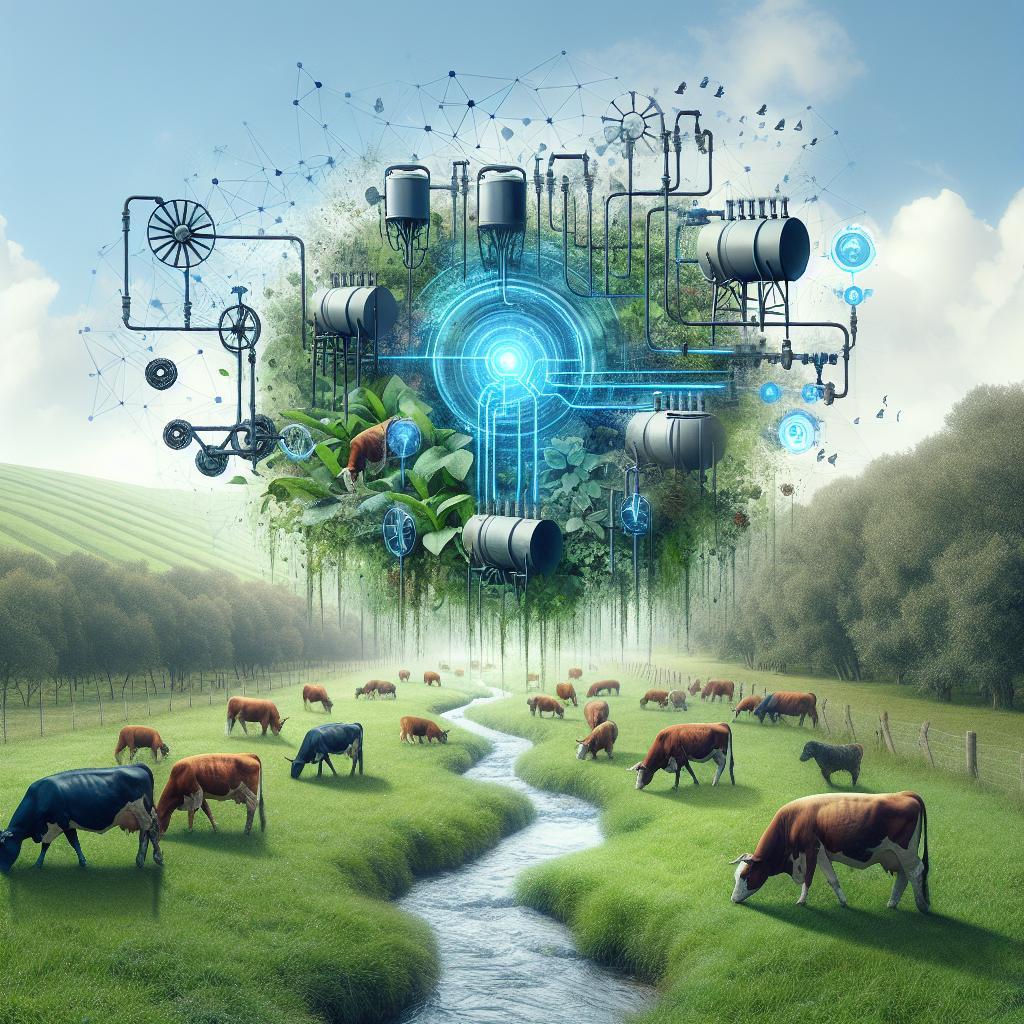This post may contain affiliate links which means I may receive a commission for purchases made through links. Learn more on my Private Policy page.
Choosing the Right Irrigation System for Livestock and Pasture Management
When it comes to nurturing healthy livestock and vibrant pastures, the road to success often flows through the right irrigation system. Picture this: a sun-drenched landscape where lush grasses sway gently in the breeze, welcoming grazing animals with the promise of nourishment and vitality. But how do you bring this idyllic vision to life? The answer lies in a thoughtful approach to irrigation—one that balances the needs of your animals, your pasture, and the precious resources of our planet.
In this friendly guide, we’ll explore the ins and outs of irrigation systems, helping you make informed choices that will not only enhance the health of your pastures but also ensure the well-being of your livestock. From traditional watering techniques to innovative technology, we’ll cover the essentials you need to know, allowing you to cultivate an environment where both pastureland and livestock can thrive. So grab a cup of coffee, roll up your sleeves, and let’s dive into the world of irrigation systems that can transform your farming practice into a sustainable and fruitful venture!
Understanding Water Needs for Your Livestock and Pasture
Understanding the specific water needs of your livestock and pasture is essential for optimizing health and productivity. Different types of livestock have varying water requirements, influenced by factors such as size, age, and activity level. For example, cattle generally need between 10 to 14 gallons of water daily, whereas sheep may require only 1 to 3 gallons. This variability means that you must tailor your irrigation system to ensure a consistent supply that meets the needs of your animals. Additionally, the moisture requirements for pasture grasses can fluctuate depending on climate and soil type, making it crucial to regularly assess soil moisture levels and grass health.
To efficiently manage water resources for your pasture and livestock, consider the following key factors:
- Soil Type: Sandy soils drain quickly, while clay retains water longer, affecting irrigation frequency.
- Climate: Hotter regions may require more frequent watering for both livestock and vegetation.
- Water Sources: Identify the proximity and reliability of your water sources for consistent access.
- System Types: Opt for systems that provide flexibility, such as drip or sprinkler irrigation, depending on your specific landscape needs.
| Livestock Type | Daily Water Requirement |
|---|---|
| Cattle | 10 – 14 gallons |
| Sheep | 1 – 3 gallons |
| Goats | 2 – 4 gallons |
| Horses | 8 – 12 gallons |

Exploring Different Irrigation Solutions: Which Fits Your Farm Best
When it comes to managing livestock and pastures, choosing the right irrigation system is crucial for ensuring optimal growth and health of your forage. Various irrigation options are available, each with its set of benefits and limitations. Consider the following solutions:
- Drip Irrigation: Ideal for targeted watering, this method minimizes water waste and is perfect for smaller, more controlled areas.
- Sprinkler Systems: Versatile and effective, these systems can cover larger fields and are adaptable to different crop types.
- Surface Irrigation: A traditional approach that utilizes gravity, this method is cost-effective but may require more management in terms of water runoff and distribution.
- Subsurface Irrigation: Piping buried beneath the soil allows for deep watering, reducing evaporation and ensuring that water reaches plant roots efficiently.
In evaluating which system will fit your farm best, consider factors such as water availability, soil type, and the specific needs of your livestock. The following table provides a quick comparison of the main irrigation systems:
| Irrigation System | Water Efficiency | Initial Cost | Maintenance |
|---|---|---|---|
| Drip Irrigation | High | Moderate | Low |
| Sprinkler Systems | Medium | High | Moderate |
| Surface Irrigation | Low | Low | High |
| Subsurface Irrigation | Very High | High | Moderate |
Ultimately, securing the right irrigation solution not only influences the financial aspects of your farm but also the sustainability and productivity of your pasture ecosystem. Take the time to evaluate how each system aligns with your goals, and remember to plan for future changes in climate and farming practices.

Creating a Sustainable Irrigation Plan for Long-Term Success
Developing a sustainable irrigation plan is essential for maintaining healthy pastures and livestock management over the long term. A well-structured plan considers not just the immediate needs of your crops and animals but also the environmental impact and water conservation. To begin, assess your current water resources and demands while identifying which type of irrigation system will suit your land and livestock best. Factors to consider include:
- Soil Type: Understand the water retention capabilities of your soil.
- Climate: Take into account rainfall patterns and temperature variations.
- Pasture Type: Different grasses have unique watering needs.
- Livestock Needs: Ensure adequate water supplies for drinking and grazing.
After evaluating these factors, select from diverse irrigation methods such as drip, sprinkler, or surface irrigation systems, each offering distinct benefits. For example, drip irrigation delivers water directly to the plant’s root zone, minimizing evaporation and runoff, whereas sprinkler systems are ideal for larger areas. It’s crucial to also incorporate water-saving technologies like moisture sensors and rainwater harvesting systems into your plan. Below is a quick comparison table of popular irrigation options:
| Irrigation Method | Water Efficiency | Cost |
|---|---|---|
| Drip Irrigation | 90-95% | Medium |
| Sprinkler Irrigation | 70-80% | Medium |
| Surface Irrigation | 60-70% | Low |

Maximizing Efficiency: Tips for Maintaining Your Irrigation System
To ensure your irrigation system runs at peak performance, routine checks and maintenance are essential. Start by inspecting key components such as filters, valves, and emitters regularly. Any buildup of sediment can lead to clogs and inefficiencies, directly affecting your livestock’s water needs. Keep the system clean by ensures that these parts are free from dirt and debris. Here are a few simple tips to keep your system in top shape:
- Inspect for leaks: Regularly check pipes and connections for cracks or leaks, which can waste water and resources.
- Adjust timers: Ensure that your timers are set correctly to avoid over or under-watering.
- Test zones: Periodically test each irrigation zone for even distribution, making adjustments as needed.
In addition to regular inspections, scheduling seasonal maintenance can help extend the life of your system. Create a maintenance calendar to remind you of tasks like draining and winterizing in colder months. Furthermore, consider keeping a log of any repairs or upgrades to track the system’s performance over time. Below is a handy table summarizing maintenance tasks:
| Maintenance Task | Frequency |
|---|---|
| Check for leaks | Monthly |
| Clean filters | Every 3 months |
| Inspect emitters/emitters | Seasonally |
| Adjust system settings | As needed |
Concluding Remarks
As we wrap up our journey through the lush fields of irrigation systems for livestock and pasture management, remember that the right choice can be as essential as the first rays of sunlight on a dewy morning. Just like your animals thrive when given the best care, your pastures will flourish with the perfect irrigation solution tailored to their unique needs.
Don’t be afraid to dive in, explore the options, and seek advice from fellow farmers or experts in the field. Whether you lean toward the efficiency of drip systems, the adaptability of sprinklers, or the simplicity of hand watering, the goal remains the same: to nurture a thriving ecosystem that benefits both your livestock and your land.
So, roll up your sleeves and step into the world of irrigation with confidence. This is a chance to create a sustainable future, one drop at a time! Happy farming, and may your pastures be ever green and your livestock ever flourishing!
This post may contain affiliate links which means I may receive a commission for purchases made through links. Learn more on my Private Policy page.

